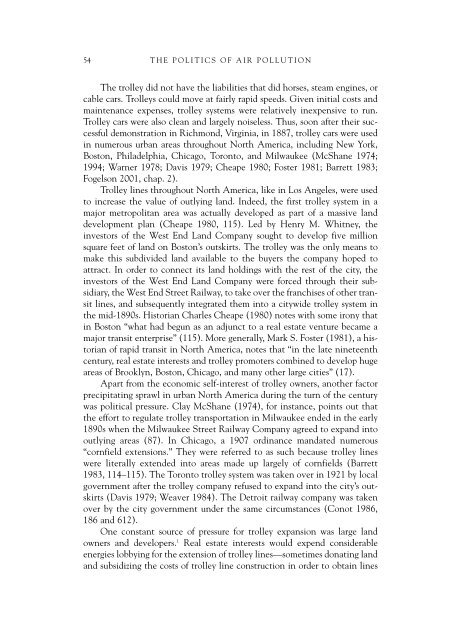GEORGE A. GONZALEZ - fieldi
GEORGE A. GONZALEZ - fieldi
GEORGE A. GONZALEZ - fieldi
Create successful ePaper yourself
Turn your PDF publications into a flip-book with our unique Google optimized e-Paper software.
54THE POLITICS OF AIR POLLUTIONThe trolley did not have the liabilities that did horses, steam engines, orcable cars. Trolleys could move at fairly rapid speeds. Given initial costs andmaintenance expenses, trolley systems were relatively inexpensive to run.Trolley cars were also clean and largely noiseless. Thus, soon after their successfuldemonstration in Richmond, Virginia, in 1887, trolley cars were usedin numerous urban areas throughout North America, including New York,Boston, Philadelphia, Chicago, Toronto, and Milwaukee (McShane 1974;1994; Warner 1978; Davis 1979; Cheape 1980; Foster 1981; Barrett 1983;Fogelson 2001, chap. 2).Trolley lines throughout North America, like in Los Angeles, were usedto increase the value of outlying land. Indeed, the first trolley system in amajor metropolitan area was actually developed as part of a massive landdevelopment plan (Cheape 1980, 115). Led by Henry M. Whitney, theinvestors of the West End Land Company sought to develop five millionsquare feet of land on Boston’s outskirts. The trolley was the only means tomake this subdivided land available to the buyers the company hoped toattract. In order to connect its land holdings with the rest of the city, theinvestors of the West End Land Company were forced through their subsidiary,the West End Street Railway, to take over the franchises of other transitlines, and subsequently integrated them into a citywide trolley system inthe mid-1890s. Historian Charles Cheape (1980) notes with some irony thatin Boston “what had begun as an adjunct to a real estate venture became amajor transit enterprise” (115). More generally, Mark S. Foster (1981), a historianof rapid transit in North America, notes that “in the late nineteenthcentury, real estate interests and trolley promoters combined to develop hugeareas of Brooklyn, Boston, Chicago, and many other large cities” (17).Apart from the economic self-interest of trolley owners, another factorprecipitating sprawl in urban North America during the turn of the centurywas political pressure. Clay McShane (1974), for instance, points out thatthe effort to regulate trolley transportation in Milwaukee ended in the early1890s when the Milwaukee Street Railway Company agreed to expand intooutlying areas (87). In Chicago, a 1907 ordinance mandated numerous“cornfield extensions.” They were referred to as such because trolley lineswere literally extended into areas made up largely of cornfields (Barrett1983, 114–115). The Toronto trolley system was taken over in 1921 by localgovernment after the trolley company refused to expand into the city’s outskirts(Davis 1979; Weaver 1984). The Detroit railway company was takenover by the city government under the same circumstances (Conot 1986,186 and 612).One constant source of pressure for trolley expansion was large landowners and developers. 1 Real estate interests would expend considerableenergies lobbying for the extension of trolley lines—sometimes donating landand subsidizing the costs of trolley line construction in order to obtain lines









